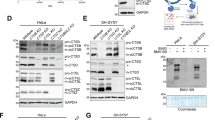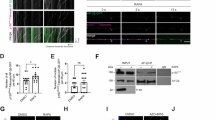Abstract
O-GlcNAcylation is a dynamic post-translational modification that takes place on ser/thr residues of nucleocytoplasmic proteins. O-GlcNAcylation regulates almost all cellular events as a nutrient sensor, a transcriptional and translational regulator, and a disease-related factor. Although the role of O-GlcNAcylation in insulin signaling and metabolism are well established, the relationship between O-GlcNAcylation and autophagy is largely unknown. Here, we manipulated O-GlcNAcylation in Drosophila and found that it regulates autophagy through Akt/dFOXO signaling. We demonstrate that O-GlcNAcylation and the levels of O-GlcNAc transferase (OGT) are increased during starvation. Furthermore, Atg proteins and autolysosomes are increased in OGT-reduced flies without fasting. Atg proteins and autophagosomes are reduced in OGT-overexpressing flies. Our results suggest that not only autophagy gene expression but also autophagic structures are regulated by OGT through Akt and dFOXO. These data imply that O-GlcNAcylation is important in modulating autophagy as well as insulin signaling in Drosophila.





Similar content being viewed by others
References
Dias WB, Cheung WD, Hart GW (2012) O-GlcNAcylation of kinases. Biochem Biophys Res Commun 422:224–228
Ruan HB, Singh JP, Li MD, Wu J, Yang X (2013) Cracking the O-GlcNAc code in metabolism. Trends Endocrinol Metab 24:301–309
Zachara NE, Hart GW (2004) O-GlcNAc a sensor of cellular state: the role of nucleocytoplasmic glycosylation in modulating cellular function in response to nutrition and stress. Biochim Biophys Acta 1673:13–28
Mehrpour M, Esclatine A, Beau I, Codogno P (2010) Autophagy in health and disease. 1. Regulation and significance of autophagy: an overview. Am J Physiol Cell Physiol 298:C776–C785
Mizushima N, Komatsu M (2011) Autophagy: renovation of cells and tissues. Cell 147:728–741
Rusten TE, Lindmo K, Juhasz G, Sass M, Seglen PO, Brech A, Stenmark H (2004) Programmed autophagy in the Drosophila fat body is induced by ecdysone through regulation of the PI3K pathway. Dev Cell 7:179–192
Fujitani Y, Ebato C, Uchida T, Kawamori R, Watada H (2009) Beta-cell autophagy: a novel mechanism regulating beta-cell function and mass: lessons from beta-cell-specific Atg7-deficient mice. Islets 1:151–153
Erickson JR, Pereira L, Wang L, Han G, Ferguson A, Dao K, Copeland RJ, Despa F, Hart GW, Ripplinger CM et al (2013) Diabetic hyperglycaemia activates CaMKII and arrhythmias by O-linked glycosylation. Nature 502:372–376
Liu K, Paterson AJ, Chin E, Kudlow JE (2000) Glucose stimulates protein modification by O-linked GlcNAc in pancreatic beta cells: linkage of O-linked GlcNAc to beta cell death. Proc Natl Acad Sci USA 97:2820–2825
Ma J, Hart GW (2013) Protein O-GlcNAcylation in diabetes and diabetic complications. Expert Rev Proteomics 10:365–380
Marsh SA, Powell PC, Dell’italia LJ, Chatham JC (2013) Cardiac O-GlcNAcylation blunts autophagic signaling in the diabetic heart. Life Sci 92(11):648–656
Wang P, Lazarus BD, Forsythe ME, Love DC, Krause MW, Hanover JA (2012) O-GlcNAc cycling mutants modulate proteotoxicity in Caenorhabditis elegans models of human neurodegenerative diseases. Proc Natl Acad Sci USA 109:17669–17674
Kumar A, Singh PK, Parihar R, Dwivedi V, Lakhotia SC, Ganesh S (2014) Decreased O-linked GlcNAcylation protects from cytotoxicity mediated by huntingtin exon1 protein fragment. J Biol Chem 289:13543–13553
Park S, Park SH, Baek JY, Jy YJ, Kim KS, Roth J, Cho JW, Choe KM (2011) Protein O-GlcNAcylation regulates Drosophila growth through the insulin signaling pathway. Cell Mol Life Sci 68:3377–3384
Sinclair DA, Syrzycka M, Macauley MS, Rastgardani T, Komljenovic I, Vocadlo DJ, Brock HW, Honda BM (2009) Drosophila O-GlcNAc transferase (OGT) is encoded by the Polycomb group (PcG) gene, super sex combs (sxc). Proc Natl Acad Sci USA 106:13427–13432
Gupta VK, Scheunemann L, Eisenberg T, Mertel S, Bhukel A, Koemans TS, Kramer JM, Liu KS, Schroeder S, Stunnenberg HG et al (2013) Restoring polyamines protects from age-induced memory impairment in an autophagy-dependent manner. Nat Neurosci 16:1453–1460
Mizushima N, Yoshimori T, Ohsumi Y (2011) The role of Atg proteins in autophagosome formation. Annu Rev Cell Dev Biol 27:107–132
Nezis IP, Shravage BV, Sagona AP, Lamark T, Bjorkoy G, Johansen T, Rusten TE, Brech A, Baehrecke EH, Stenmark H (2010) Autophagic degradation of dBruce controls DNA fragmentation in nurse cells during late Drosophila melanogaster oogenesis. J Cell Biol 190:523–531
Wang B, Moya N, Niessen S, Hoover H, Mihaylova MM, Shaw RJ, Yates JR 3rd, Fischer WH, Thomas JB, Montminy M (2011) A hormone-dependent module regulating energy balance. Cell 145:596–606
Sengupta A, Molkentin JD, Yutzey KE (2009) FoxO transcription factors promote autophagy in cardiomyocytes. J Biol Chem 284:28319–28331
Bai Hua, Kang Ping, Hernandez Ana Maria, Tatar Marc (2013) Activin signaling targeted by insulin/dFOXO regulates aging and muscle proteostasis in Drosophila. PLoS Genet 9(11):e1003941
Housley MP, Rodgers JT, Udeshi ND, Kelly TJ, Shabanowitz J, Hunt DF, Puigserver P, Hart GW (2008) O-GlcNAc regulates FoxO activation in response to glucose. J Biol Chem 283:16283–16292
Juhasz G, Puskas LG, Komonyi O, Erdi B, Maroy P, Neufeld TP, Sass M (2007) Gene expression profiling identifies FKBP39 as an inhibitor of autophagy in larval Drosophila fat body. Cell Death Differ 14:1181–1190
Villa-Cuesta E, Sage BT, Tatar M (2010) A role for Drosophila dFoxO and dFoxO 5′UTR internal ribosomal entry sites during fasting. PloS One 5(7):e11521
Kim EY, Jeong EH, Park S, Jeong HJ, Edery I, Cho JW (2012) A role for O-GlcNAcylation in setting circadian clock speed. Genes Dev 26:490–502
Scott RC, Schuldiner O, Neufeld TP (2004) Role and regulation of starvation-induced autophagy in the Drosophila fat body. Dev Cell 7:167–178
Juhasz G, Csikos G, Sinka R, Erdelyi M, Sass M (2003) The Drosophila homolog of Aut1 is essential for autophagy and development. FEBS Lett 543:154–158
Thummel CS (2001) Steroid-triggered death by autophagy. Bioessays 23:677–682
Ravikumar B, Sarkar S, Davies JE, Futter M, Garcia-Arencibia M, Green-Thompson ZW, Jimenez-Sanchez M, Korolchuk VI, Lichtenberg M, Luo S et al (2010) Regulation of mammalian autophagy in physiology and pathophysiology. Physiol Rev 90:1383–1435
Yuzwa SA, Macauley MS, Heinonen JE, Shan X, Dennis RJ, He Y, Whitworth GE, Stubbs KA, McEachern EJ, Davies GJ et al (2008) A potent mechanism-inspired O-GlcNAcase inhibitor that blocks phosphorylation of tau in vivo. Nat Chem Biol 4:483–490
Puig O, Marr MT, Ruhf ML, Tjian R (2003) Control of cell number by Drosophila FOXO: downstream and feedback regulation of the insulin receptor pathway. Genes Dev 17:2006–2020
Lee KS, Kwon OY, Lee JH, Kwon K, Min KJ, Jung SA, Kim AK, You KH, Tatar M, Yu K (2008) Drosophila short neuropeptide F signalling regulates growth by ERK-mediated insulin signalling. Nat Cell Biol 10(4):468–475
Acknowledgments
We thank K. M. Choe, and K. Yu for fly stocks and DNA clones, and O. Puig and K. Yu for providing the anti dFOXO antibody. We are also grateful to other members of the Cho and Choe laboratories for helpful discussions. This work is partly supported by the Graduate School of Yonsei University. This work was supported by Basic Science Research Program through the National Research Foundation of Korea (NRF) funded by the Ministry of Education, Science and Technology (NRF-2013R1A2A1A01008067) to J. W. C.
Conflict of interest
The authors declare that they have no conflicts of interest to declare.
Author information
Authors and Affiliations
Corresponding authors
Additional information
J. Roth and J. W. Cho are co-corresponding authors.
Electronic supplementary material
Below is the link to the electronic supplementary material.
18_2015_1889_MOESM1_ESM.tif
Supplementary material 1 Figure S1. The effects of increased OGT or OGT knockdown on overall O-GlcNAc levels. (A) Larval lysates from UAS-OGT and Act>OGT in feeding and fasting were analyzed by immunoblot with RL2 antibody. (B) Larvae lysates used for immunoblotting from UAS-OGTi and Act>OGTi in feeding and fasting to detect overall O-GlcNAc levels (TIFF 7877 kb)
18_2015_1889_MOESM2_ESM.tif
Supplementary material 2 Figure S2. The effect of O-GlcNAcylation on protein levels of Atg8a and the number of lysosomes. (A) S2 cells were transfected with pMT-FLAG-dogt for 48 h and harvested for immunoblotting. Anti-RL2, anti-FLAG, anti-β-actin, and anti-Atg8a antibodies are used. (B) Quantification of the amount of Atg8a in (A) (*p<0.05, student’s t-test). (C) A morphometric evaluation of EM images (***p<0.001, student’s t-test). TEM reveals many lysosomes in OGT-overexpressing larval fat bodies (TIFF 10380 kb)
18_2015_1889_MOESM3_ESM.tif
Supplementary material 3 Figure S3. O-GlcNAcylated proteins of the autophagy pathway. (A) S2 cells were treated with 10μM PP242 for 4 h to induce autophagy. Representative western blots showing β-actin and Atg8a in control and PP242-treated S2 cells. Lysates were prepared and analyzed either directly by immunoblotting (Input) or following pull-down with sWGA-agarose to detect O-GlcNAc modification on dFOXO. (B) WT mice were treated with the O-GlcNAcase inhibitor, thiamet-G (TG) for 7 days to increase total O-GlcNAcylation. Total O-GlcNAcylation of control and thiamet-G injected mouse brain. (C) To demonstrate O-GlcNAcylation on Atg7, Atg7 was immunoprecipitated using specific O-GlcNAc antibody followed by Western blotting with anti-Atg7 antibody. Brain lysates were prepared and analyzed either directly by immunoblotting or following pull-down with sWGA agarose to detect O-GlcNAcylation on Atg7, LC3, and Atg5. β-actin was used as a loading control. (D) Control and PP242-treated S2 cell lysates were prepared and analyzed either directly by immunoblotting as input or following pull-down with sWGA agarose to detect O-GlcNAcylation on dAtg5 and Atg8a. β-actin was used as a loading control. (E) Whole cell lysate of GFP-mCherry-Atg8a-expressing larvae with feeding or fasting. Larval lysates were prepared and analyzed either directly by immunoblotting (input) or following pull-down with sWGA agarose to detect O-GlcNAcylation on Atg8a using mCherry and GFP antibodies. Upper arrow is mCherry-GFP-Atg8a and lower arrow is free mCherry. β-actin was used as a loading control (TIFF 173286 kb)
Rights and permissions
About this article
Cite this article
Park, S., Lee, Y., Pak, J.W. et al. O-GlcNAc modification is essential for the regulation of autophagy in Drosophila melanogaster . Cell. Mol. Life Sci. 72, 3173–3183 (2015). https://doi.org/10.1007/s00018-015-1889-z
Received:
Revised:
Accepted:
Published:
Issue Date:
DOI: https://doi.org/10.1007/s00018-015-1889-z




